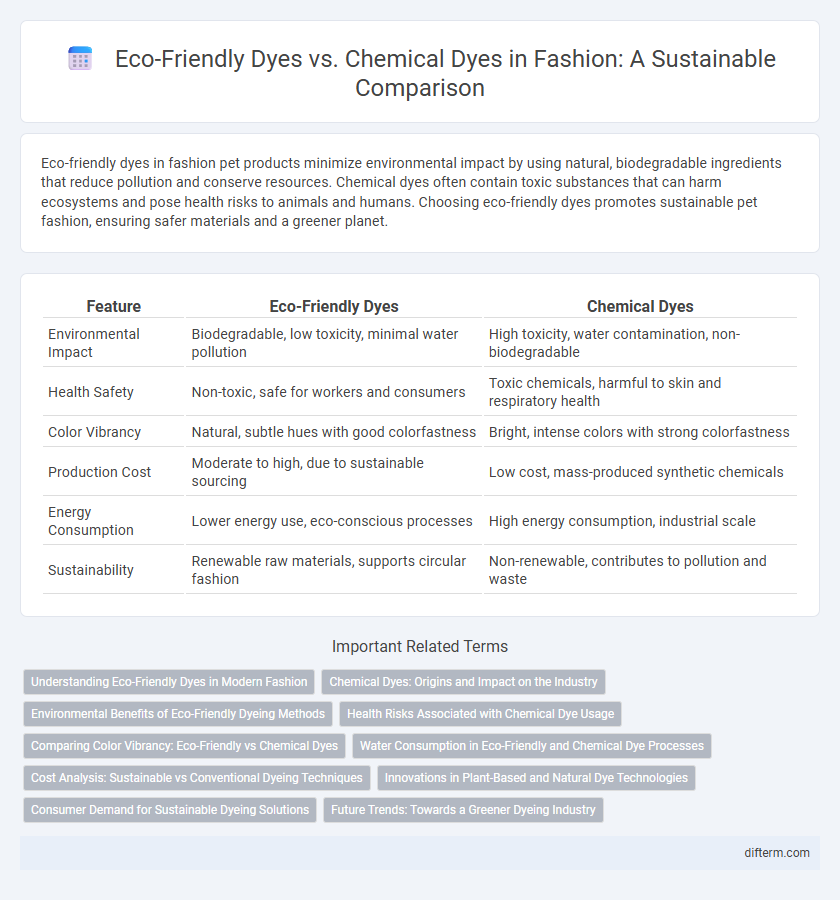Eco-friendly dyes in fashion pet products minimize environmental impact by using natural, biodegradable ingredients that reduce pollution and conserve resources. Chemical dyes often contain toxic substances that can harm ecosystems and pose health risks to animals and humans. Choosing eco-friendly dyes promotes sustainable pet fashion, ensuring safer materials and a greener planet.
Table of Comparison
| Feature | Eco-Friendly Dyes | Chemical Dyes |
|---|---|---|
| Environmental Impact | Biodegradable, low toxicity, minimal water pollution | High toxicity, water contamination, non-biodegradable |
| Health Safety | Non-toxic, safe for workers and consumers | Toxic chemicals, harmful to skin and respiratory health |
| Color Vibrancy | Natural, subtle hues with good colorfastness | Bright, intense colors with strong colorfastness |
| Production Cost | Moderate to high, due to sustainable sourcing | Low cost, mass-produced synthetic chemicals |
| Energy Consumption | Lower energy use, eco-conscious processes | High energy consumption, industrial scale |
| Sustainability | Renewable raw materials, supports circular fashion | Non-renewable, contributes to pollution and waste |
Understanding Eco-Friendly Dyes in Modern Fashion
Eco-friendly dyes in modern fashion utilize natural ingredients such as plant extracts, minerals, and microorganisms to reduce environmental impact and improve biodegradability. These dyes often require less water and energy during production, minimizing pollution compared to conventional chemical dyes that contain toxic substances like heavy metals and synthetic chemicals. Brands adopting eco-friendly dyes contribute to sustainable fashion by promoting safer manufacturing processes and healthier ecosystems.
Chemical Dyes: Origins and Impact on the Industry
Chemical dyes, derived from synthetic compounds created in the 19th century, revolutionized the fashion industry by offering vibrant, long-lasting colors and mass-production capabilities. These dyes often contain toxic substances like heavy metals and azo compounds, which pose significant environmental hazards through water pollution and soil contamination during manufacturing and disposal. The widespread use of chemical dyes has driven industry innovation but also triggered growing concerns about sustainability and health impacts, prompting shifts towards safer alternatives.
Environmental Benefits of Eco-Friendly Dyeing Methods
Eco-friendly dyes significantly reduce water pollution by using natural, biodegradable ingredients that minimize toxic runoff into ecosystems. These sustainable dyeing methods decrease energy consumption and carbon emissions compared to conventional chemical dyes, supporting climate change mitigation efforts. Incorporating plant-based or low-impact dyes enhances soil health and promotes biodiversity by avoiding harmful synthetic chemicals in textile production.
Health Risks Associated with Chemical Dye Usage
Chemical dyes commonly used in fashion release toxic substances such as heavy metals and carcinogens that can cause skin irritation, respiratory problems, and long-term health issues. Prolonged exposure to these harmful chemicals increases the risk of allergic reactions, eczema, and even cancer among workers and consumers. Eco-friendly dyes minimize these health risks by using natural, non-toxic ingredients derived from plants and minerals, promoting safer manufacturing and wear.
Comparing Color Vibrancy: Eco-Friendly vs Chemical Dyes
Eco-friendly dyes often provide softer, more natural hues compared to the intense, vivid colors produced by chemical dyes, which are engineered for maximum brightness and consistency. While chemical dyes offer a wider color palette and higher colorfastness, eco-friendly alternatives prioritize sustainability, sometimes resulting in slightly muted but unique, earthy tones. Innovations in plant-based and mineral dyes are closing the gap in vibrancy, making eco-friendly dyes increasingly viable for fashion brands aiming for both impact and environmental responsibility.
Water Consumption in Eco-Friendly and Chemical Dye Processes
Eco-friendly dyes significantly reduce water consumption compared to traditional chemical dyes, using up to 90% less water during the dyeing process. Chemical dyeing often requires large volumes of water for dilution, washing, and treatment of toxic effluents, leading to severe environmental strain. Brands adopting natural, plant-based, or low-impact dyes contribute to sustainable fashion by minimizing water waste and pollution in textile manufacturing.
Cost Analysis: Sustainable vs Conventional Dyeing Techniques
Eco-friendly dyes typically incur higher initial costs due to sourcing natural ingredients and longer processing times compared to chemical dyes, which benefit from mass production and established supply chains. However, sustainable dyeing techniques reduce expenses in wastewater treatment and regulatory compliance, offsetting upfront investments over time. Brands adopting eco-friendly dyes often see improved market value and consumer loyalty, contributing to long-term financial benefits beyond direct cost comparisons.
Innovations in Plant-Based and Natural Dye Technologies
Innovations in plant-based and natural dye technologies are revolutionizing sustainable fashion by offering eco-friendly alternatives to chemical dyes, significantly reducing environmental pollution and water consumption. Advanced extraction methods and bio-engineering of pigments from plants like indigo, marigold, and turmeric enhance color fastness and vibrancy, meeting industry standards for durability and aesthetics. These cutting-edge natural dyes contribute to circular fashion practices by supporting biodegradable textile treatments and minimizing toxic waste in manufacturing.
Consumer Demand for Sustainable Dyeing Solutions
Consumer demand for sustainable dyeing solutions is rapidly increasing as awareness of environmental impacts grows. Eco-friendly dyes significantly reduce water pollution and toxic chemical use compared to traditional chemical dyes, aligning with the values of environmentally conscious shoppers. Brands adopting natural or low-impact dyeing methods see stronger customer loyalty and market differentiation in the competitive fashion industry.
Future Trends: Towards a Greener Dyeing Industry
Eco-friendly dyes derived from natural sources reduce water pollution and toxic chemical residues compared to conventional chemical dyes, supporting sustainable fashion practices. Innovations in biodegradable dye formulations and microbial pigment production promise enhanced colorfastness and lower environmental impact. Industry projections indicate a significant shift towards greener dyeing technologies driven by regulatory pressures and consumer demand for eco-conscious apparel.
Eco-friendly dyes vs chemical dyes Infographic

 difterm.com
difterm.com